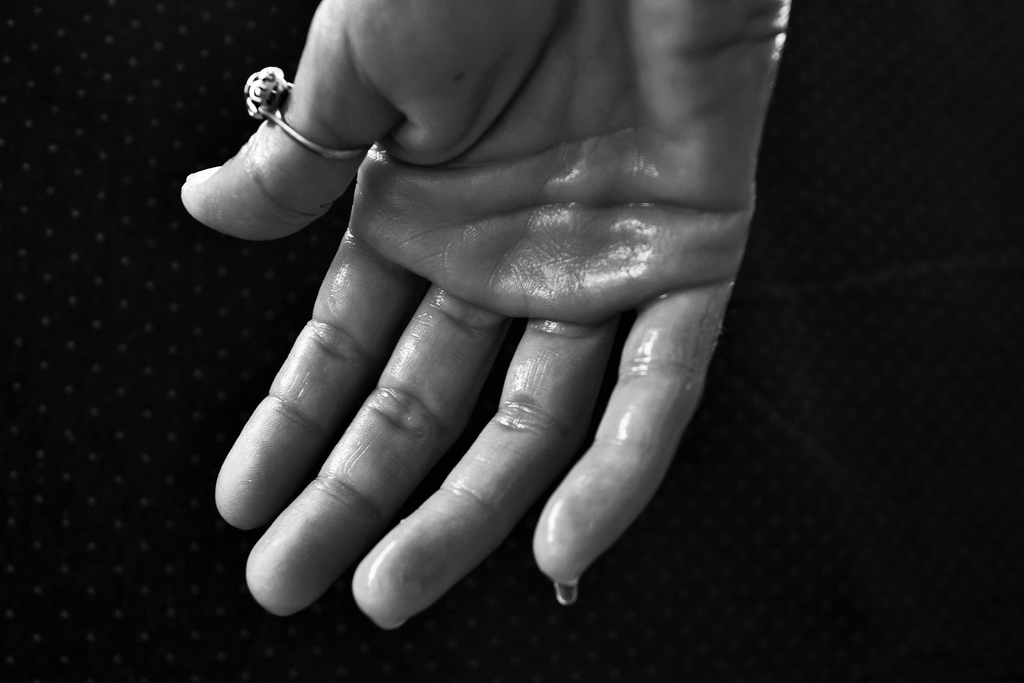Written by Daria Sysoeva and Edited by Sorina Long

Hyperhidrosis is a medical condition characterized by excessive sweating. Normally, the body produces sweat in order to regulate its temperature when exercising or in a hot environment. However, the body can also produce sweat when triggered by emotional stressors such as fear or embarrassment [1]. However, a person diagnosed with hyperhidrosis excessively sweats, regardless of the situation [2]. This condition is reported as being rare in the United States, as a 2016 study suggests that approximately 15.3 million Americans, or less than five percent of the U.S population, have hyperhidrosis. While this number may seem small, many researchers believe that hyperhidrosis is often underreported and underdiagnosed [2].
Hyperhidrosis is divided into two categories: focal and generalized [2]. Focal hyperhidrosis is characterized by sweating in one or more body parts while generalized hyperhidrosis involves sweating throughout the whole body. Focal hyperhidrosis usually occurs in healthy people and is hereditary, or passed on through genes. By contrast, generalized hyperhidrosis is usually caused by underlying conditions, including infections or brain disorders [3].
To determine the severity of the condition and the origin of sweating, the starch-iodine test is often performed by healthcare professionals [1]. First, an alcohol solution is applied to the skin to thoroughly dry it out, followed by an application of iodine after a few minutes. Afterward, starch is sprinkled on the skin. Then, the individual is placed in a room with an elevated temperature or asked to exercise to encourage sweating. Once the sweat makes contact with the starch and the iodine, a chemical reaction occurs and turns the skin dark blue. The physician then examines the dark blue patches and is able to determine which body parts are more affected by hyperhidrosis in addition to its severity [4].
Hyperhidrosis can have significant effects on an individual’s quality of life. In a 2017 survey, researchers found that many individuals diagnosed with hyperhidrosis have reported that their condition regularly makes them feel embarrassed, sad, or angry, leading to poor self-esteem [5]. Overall, many people with this condition have reported that hyperhidrosis severely interferes with their daily activities and prevents them from living fulfilling lives [5]. Moreover, normal human interaction is also greatly inhibited as hyperhidrosis patients avoid holding hands or touching other people. This reluctance to participate in human interaction due to this condition also may contribute to the poor emotional and mental health of hyperhidrosis patients [5].
Topical creams and Botulinum Toxin A are some examples of common treatments for hyperhidrosis. Aluminum chloride is the active ingredient in most topical creams. Its chemical composition allows it to form multiple bonds with water and thus effectively plug the sweat gland [6]. Botulinum Toxin A, commonly referred to as botox, is a toxin commonly used in cosmetic procedures and is the most effective treatment for hyperhidrosis. Botox reduces sweating by disrupting signaling between the nervous system and the sweat glands. The most common place to receive this treatment is the underarm area, but some people have it injected in their palms. The duration of effect can vary based on the location of the botox. Under the arm, botox lasts seven months, while on the palms, botox lasts about four to six months [3].
Despite effective medical treatments being available for hyperhidrosis, some people opt for natural remedies to reduce their sweating. These remedies include avoiding triggers of sweat, including caffeine and spicy foods. In addition, wearing breathable clothes and breathable shoes also helps to alleviate sweating [7]. Hyperhidrosis may sometimes be difficult to cope with; however, having a good support system, avoiding sweat triggers, trying out different treatment options, and closely following the suggestions of the dermatologist may make life with hyperhidrosis a little easier.
References:
- Schlereth, T., Dieterich, M.,Birklein, F. (2009). Hyperhidrosis–causes and treatment of enhanced sweating. Deutsches Arzteblatt international, 106:32–37.
- Doolittle, J., Walker, P., Mills, T., Thurston, J. (2016). Hyperhidrosis: an update on prevalence and severity in the United States. Archives of dermatological research, 308: 743-749.
- Haider, A., Solish, N. (2005). Focal hyperhidrosis: diagnosis and management. CMAJ: Canadian Medical Association journal = journal de l’Association medicale canadienne, 172: 69–75.
- Ribeiro, L., Rocha, R., Martins, J., Monteiro, A. (2020). Starch–iodine test: a diagnostic tool for Horner syndrome. BMJ Case Reports, 13: e238541.
- “The Effects on Patients’ Lives: Social Embarrassment and Psychological Effects.”Sweat Help, https://www.sweathelp.org/about-hyperhidrosis/the-effects-on-patients-lives/social-embarrassment-and-psychological-effects.html Accessed 17 Nov. 2020.
- Keller, D. “Aluminum chloride still helps control hyperhidrosis.” MDedge, 2016 https://www.mdedge.com/internalmedicine/article/110941/dermatology/aluminum-chloride-still-helps-control-hyperhidrosis#:~:text=BOSTON%20%E2%80%93%20Aluminum%20chloride%2C%20a%20chemical,as%20well%20as%20prescription%20products. Accessed 17 Nov. 2020.
- Doheny, K. “When You Sweat too Much.” WebMD, 2012, https://www.webmd.com/skin-problems-and-treatments/features/dont-sweat-it#1. Accessed 17 Nov. 2020.